 |
 |
Select Aquatics of Erie, CO |
 |
|
|
|
|
|
|
|
|
|
|
|
|
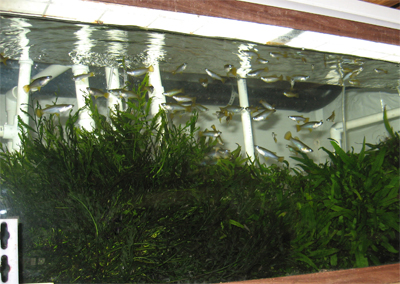 |
This is a show tank of the Alfaro cultratus,
the Knife
Livebearer. These are a peaceful schooling fish
that
generally feed at the surface. Here, they are
over a
bed of Bolbitis Fern and Java Fern in a
barebottom 55
gallon. Though the plants are thick and lush, and
you
would expect it to be great for fry, few if any
fry
survive to adulthood in this tank because of the
way
it is set up. |
|
|
|
Over the last few years, the Alfaro cultratus
has been one of the best selling fish offered, but also the one that
generates
the most questions regarding its breeding. The
young are particularly small when compared to other livebearers- thin,
translucent and about 6mm long. They are eagerly
eaten by other fish, and often are preyed upon by adults of their own
species.
As a result, some consider these to be tricky to
breed, and they are not. Like most fish, they will breed easily enough
when
healthy and well fed with good water quality, but
without following a few practices, your efforts to save and raise up the
fry
may be met without success.
When breeding livebearers, so that no fry are
lost or eaten, how to set up the tank and manage the harvesting of fry
will have
the greatest odds of success when using the
methods described here. The process explained will work for any
livebearers that
are prone to eat their fry, or with species where
the fry are known to be fragile due to small size or water quality
requirements.
By using this process, you will not only be able
to breed the Alfaros, but any other livebearer species prone to eating
their
fry, such as the Gambusias, Brachyrhaphis,
poeciliids, goodeids, etc..
Separating the female by placing her in a net
breeder will not work for the Alfaros, as with many other livebearer
species,
as the females are too large, while the fry are
too small and numerous to survive long in a confined space with a
potentially
hungry adult.
Fry are often lost, females do not do well in
small breeders, and neither the fry or the adults do well in the
temporary
crowded conditions we create in an effort to save
the fry. Also, the females of the cultratus are not marked as clearly
gravid as with many other species- their gravid
spot is not as pronounced, and what may appear to be a female about to
drop any time may go for weeks before the fry are
born.
The Alfaro cultratus gestation period is similar
to other commonly kept poeciliid livebearers, at about 4-5 weeks, and
the
females will become very plump. However, they do
not possess the dark gravid spot we are used to seeing in Guppies,
Swordtails
and Platies. A dark outlining of the abdominal
cavity may appear, and it is possible to identify gravid females easily
enough,
but the signs you are looking for are more subtle
than they are with other livebearers. |
 |
|
|
| |
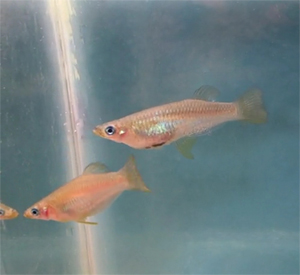 |
|
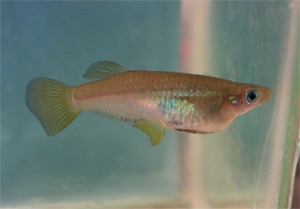 |
|
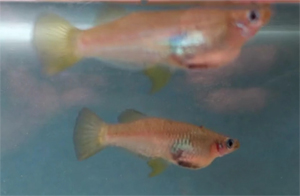 |
|
|
|
These females are about to pop, what you
see here is as dark a gravid spot as this species
will show. |
 |
|
|
|
A slightly more gravid female. The
dark spot
behind her abdomen is not yet clearly seen. |
|
A. cultratus pair. Note the male's stick
like
gonopodium. This female may be slightly gravid. |
|
|
|
|
|
Because the fry are so small and the batches can be
fairly large, I use only 10, 15 or 20 gallon breeder tanks to breed the
alfaros. I have tried larger homemade breeders
that hang inside a tank, with some success, but assume a few of the fry
were
eaten, and more importantly, the adult females
did not do well confined as they were. They are a schooling fish
accustomed to
skimming the tank just below the surface looking
for food. Being held nearly stationary for up to 2-3 weeks, in a
container
with gradually deteriorating water quality, as
uneaten food accumulated, was not ideal for the females or the fragile
fry.
Using water from the home tank that the female had
come from to season the new tank, a bare bottom 10 gallon tank is filled
with
Java Moss or Java Fern. Najas grass (Guppy grass)
will also work, even the fake plastic home décor stuff that looks like
Java
moss should work, but I try to avoid harder
plastic stuff in crowded conditions as the adult fish could scrape and
harm
themselves. A firm fitting top should be used
with low to moderate light for 12-14 hrs per day. Alfaro adults, when in
a new
environment, are jumpers, but this is not a
problem with the new fry. Once there are no adults in the breeding tank
it is not
necessary to keep the tank covered. |
 |
|
|
| |
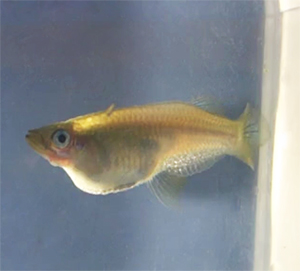 |
|
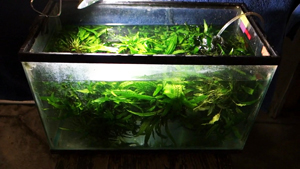 |
|
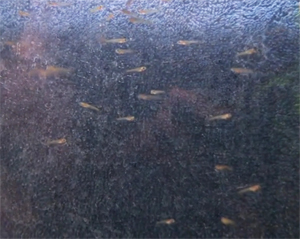 |
|
|
The breeder tank setup, using Java
Fern. The
bottom is open enough that the female can
navigate the tank, but plants are at the top
to protect fry after they first hatch and go to
the surface. The female at the left produced
62 fry in this setup. The female needs to be
removed within a couple hours of when she
gives birth. |
|
|
Newly born A. cultratus fry. |
|
|
Gravid female used for this drop of fry. |
|
|
A sponge filter that will not suck up fry should be
used, run with moderate aeration, and a dependable heater should
maintain
the temperature at 74-77 degrees. The tank should
be placed in a quiet location where disturbances are minimal.
The female Alfaro, when in a tank by herself will
tend to hide and stay near the bottom of the tank, positioning herself
as
best she can within the Java moss so she cannot
be seen.
How you place the Java moss or fern in the tank
is important. You want there to be enough plant material in the
tank such that
the female can get around, throughout most of the
tank, swimming fairly easily from one side to the other. At the
same time,
you want the Java moss to rest within the lower
portion of the tank so that there is a space of at least a half
inch of open
space at the surface.
The way I feed the female at this time is to sink
some flake food into a little water, and squirt the water/ food mix with
a
turkey baster in front of her. I make an effort
to feed only high quality flake at this time. I assume – and I may be
mistaken-
that getting the female into the habit of eating
live food, or even frozen brine shrimp or bloodworms could encourage the
female
to eat her young when they appear. So to be
“better safe than sorry”, I try not to feed anything similar in size or
movement to
the new fry at this time.
Females of most livebearers will give birth in
the morning, generally just as the sun comes up, and are usually done by
noon.
When the new cultratus fry are born, the fry will
go immediately to the surface for the first few hours, hovering above
the
Java Moss. Fortunately, the females rarely
venture to those parts of the tank when by themselves in the heavily
planted tank.
Each day that the female is in the breeding tank
I will look for fry at about 8-9 am, then again just before noon. If
even a
single fry is seen, the fry are all already born
or will be so within an hour, and the female will need to be pulled.
When the
birthing starts, it doesn’t stop until all young
are born. There are a few exceptions to this – the Heterandria Formosa,
for
example, will drop a couple young per day for up
to a week-but most of the livebearers we keep will release all of their
young
within about an hour to 90 minutes,including the
cultratus.
Using this method you can actually breed more
than one female at a time- I will often put up to 4 females at a time
into this
10 gallon tank. If there are other females in the
tank, and fry are seen swimming at the surface, I will net them out into
a
tank of their own as soon as they are seen. Once
all fry are removed, I will then remove the females that appear to have
dropped
their brood. Some fry are lost with this method,
but enough are saved to make the effort worthwhile.
One practice mentioned in other articles that
works exceptionally well for many of the livebearers is to have a female
drop her
brood, pull her, then let the fry age for a week
or two, and then put a number of gravid females into the tank. The
previous batch
will serve as dither fish to keep the new batch
from being eaten as the majority of the fry seen will be larger than
what the
female wants to ingest, but the older fry are too
small to be interested in eating the new fry themselves.
|
 |
|
|
| |
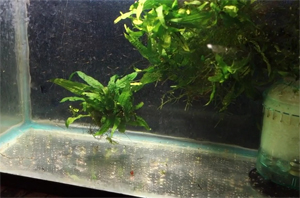 |
|
|
This
is the tank after the female was removed,
and the fry were grown out for about a month
before being split up into other tanks to grow
grow out into adulthood.
|
|
|
Once the female is pulled, gently remove the
majority of the plants, leaving the fry so they can be easily
seen. They can be
fed vinegar eels or
microworms, but will take newly hatched brine shrimp or even
finely ground dry food right away. I recommend
hatching a few batches of
brine shrimp ahead of time, filtering out the shrimp and putting
them into freshwater. The
shrimp are then frozen
into ice cube trays, and the new fry will take the frozen BBS
from the melting ice cube dropped into the
tank. When frozen soon
after hatching, the nutritional difference from live is
negligible, and the fry are guaranteed fresh
shrimp with each feeding.
When fed 2x per day they will grow quickly with water changes of
about 20% done 3-4x weekly, for
the first 2-3 weeks. As
well, quick 50% water changes may be necessary if any cloudiness
is witnessed from the deteriorating
brine shrimp feedings. At
about a month to 6 weeks old the young will be large enough to
combine with the adults, and will
sex out relatively early
at 3-4 months. In the the lower body profile of the males,
gonopodium development can start to be
seen at 2-3 months.
The fry do grow out
fairly uniformly, and there is no concern that the faster
growing, larger fry will pick on any small
broodmates. The Alfaro is
a very peaceful, good community fish that generally does well
with its own kind and other species.
As also occurs with some
species, the Alfaros when first bred in new water conditions
will sometimes produce batches that
are skewed toward one sex
or the other. I have kept, removed and reintroduced the Alfaros
to my fishroom, and have had this
sex ratio issue come up
on 3 separate occasions. Twice I was producing mostly females,
once I was producing mostly males. In
all 3 cases, by the 2nd
generation the sex ratios evened out to close to a 50/50 ratio
into the second generation.
Speculation exists as to
what causes this, and papers have been written pointing to
temperature in some species pushing the
sex ratio to one
direction or another. Warmer temperatures are generally
considered to produce more females, cooler temps in
the species studied
produced more males. pH is also an issue with some species, and
with at least one swordtail (The Xiph.
helleri Rio Otapas), a
sex ratio of more males than females issue was corrected by
feeding a finely powdered food to the fry
during their first month.
The reason that works is not clear, but may point to a slight
difference in mouth structure that
keeps the females from
being able to eat a larger flake normally, as the male fry do.
Complicating matters is
that the temperature of the current generation may influence
future sex ratios. The Xiph. Helleri,
for example, is routinely
kept warmer in home aquariums that the species experiences in
the wild. This is because
temperatures recommended
by pet stores and hobbyist information often recommend
temperatures in the upper 70s to low 80s.
Yet in the wild they are
better accustomed to temperatures that are much cooler – 68 – 75
degrees, with 72-74 being about
their ideal temperature.
Just as pet shop swords kept in the high 70s temps will likely
become ill with ich when abruptly
kept at 72 degrees, a
line of fish reproducing at near 50/50 sex ratios at 78 degrees
may produce an overabundance of males
at first when kept closer
to their natural temperatures.
In that case, just as the
gradual acclimation over 2 generations would return the Alfaros
to a normal 50/50 sex ratio,
the swords may take a
generation or two to return to normal sex ratios when exposed to
routine cooler temperatures that
can initially skew the
sex ratio.
Reasons such as this
explains advice or criticism from some looking for a quick
explanation to a problem, who often blame
the fishkeeper’s
inexperience. In fact, the understanding of acclimation issues
over many generations is not fully understood.
Even today much is still
being learned, lending an air of both uncertainty and surprise
to the keeping of these fish.
When raising the fry, a
few issues need to be considered. The Alfaros being bred in 10
gallon aquariums producing
30-50 fry will need to
be split up into smaller groups and raised separately, or moved
into a larger tank as soon as
one is available. Without
doing this, the growth of any particular fry will be stunted as
they will not have appropriate
access to the food, water
quality and simple space needed to grow. Until they are large
enough to move to other tanks easily,
the beneficial effects of
proper access to food, water quality and to some extent, space,
can be duplicated through frequent
smaller feedings, and
large – 40%+ routine water changes. However, you are just buying
time, and getting them into an
appropriate sized tank
given the tank density is essential if they are to grow into
fish that are healthy and full sized.
If you are looking to
develop the line or exploit the occasional mutation, raising
every fry up is essential. New fry
carrying a genetic
anomaly you may be interested in will likely be undersized,
weaker or not as fit to compete with its
bretheren for food and
other resources. Watching the fry closely is important, and when
an albino or leucistic fish is spotted,
you must move it to a net
breeder or smaller container of its own to raise up separately
if it is to survive and possibly be
used to start a new line
in the future.
The Alfaro cultratus line
carried here with often throw leucistic fish – a yellow or amber
body, with little to no black
coloration, and eyes that
are not blue. With these Alfaros, the leucistic form is an
overall amber color (as opposed to the
all yellow body with a
blue sheen), and smaller silver, rather than blue eyes. Not an
unattractive fish, attempts to breed
the leucistics with one
another were unsuccessful, as they have not been fertile. I am
sure with further attempts, that morph
of the fish could be
developed and bred. I have not had an albino with this species.
An albino of this fish
would be very interesting and attractive, and since they do not
seem to be produced spontaneously
as is the case with many
of the swords, finding a fertile pair of leucistic fish may
begin to produce albinos – I have
found that albinos can be
produced this way with other species.
Hopefully if I do not
find the tank space, a customer will decide to exploit these
leucistic fish that occur fairly regularly.
Here are some pics of
those fish:
|
 |
|
|
| |
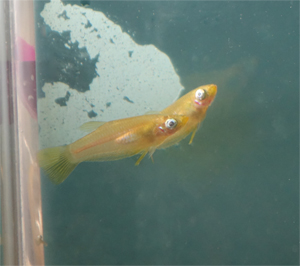 |
|
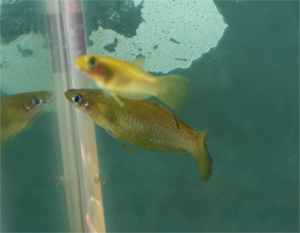 |
These are the leucistic fish thrown by
the line
kept here. They have colony bred here for over
10 years and they continue to appear, but are only
about 1% of fish born. They are almost always
males. Females have occurred, and multiple
attempts to breed them did not result in any
fry. Compare to normal colored fish on lower
right.. |
|
|
|
|
|
| |
|
|
|
|
|
|
|
|
|
|
|
|
|
|
|
|
|
|
|
|
|
|
|
|
|
|
|









